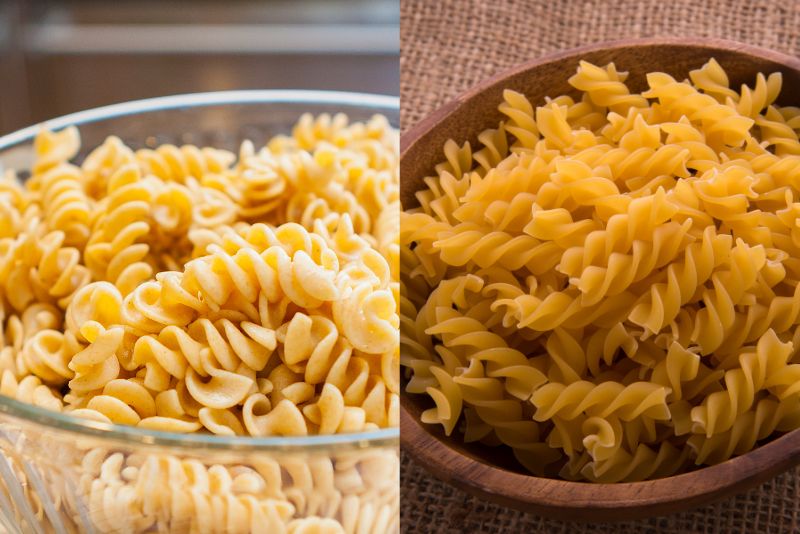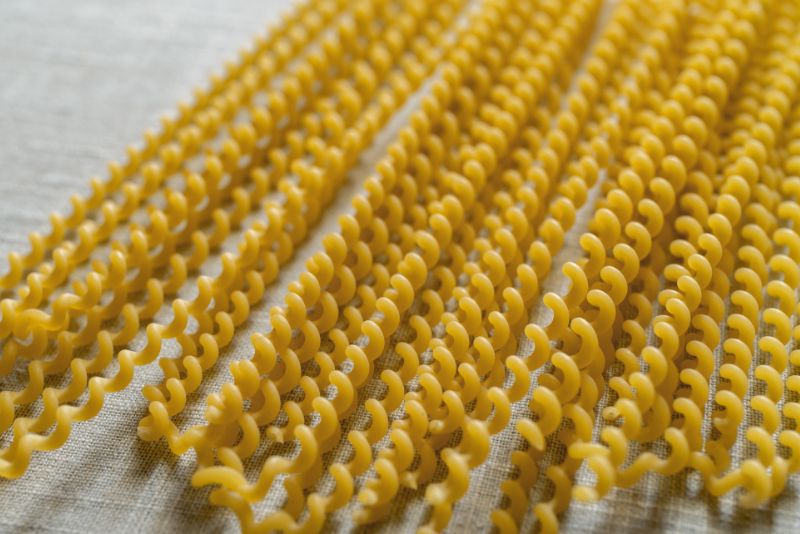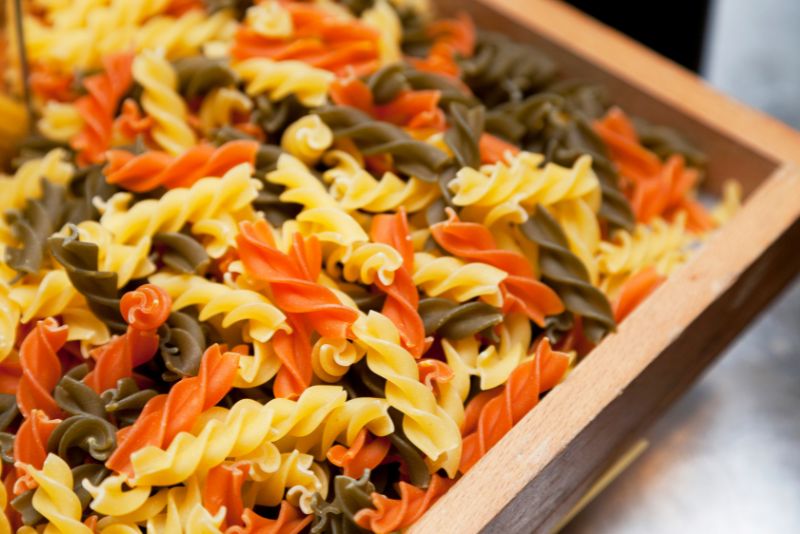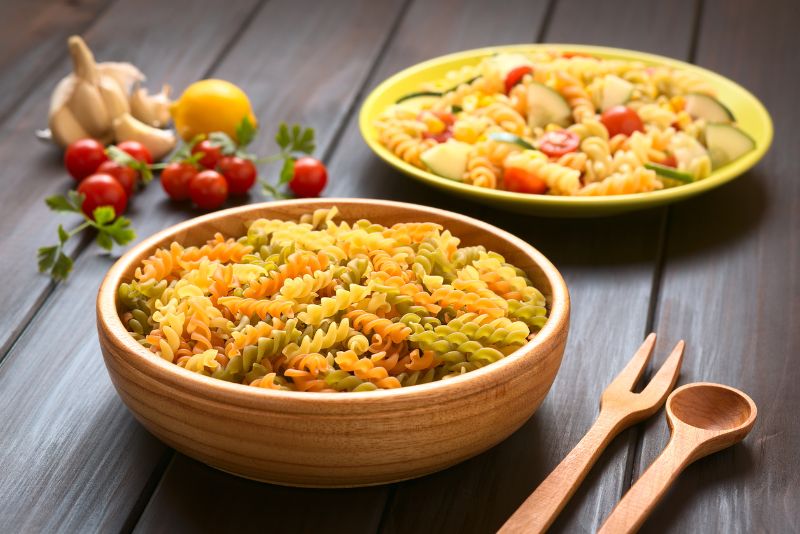Kids around the world love pasta of all different kinds, but two of their favorites are Fusilli and Rotini. At first glance, both of these wonderful noodles are very similar, but there are a handful of differences. Today, we’re going to look at Fusilli vs Rotini and discuss the differences between them.
Table of Contents
What is Fusilli?
Fusilli (pronounced foo-zee-lee), derived from the word “fuso”, meaning spindle, is a small, corkscrew-shaped pasta made from semolina flour that is often thick and cut into short 2-inch sections.
Fusilli got its name because the pasta was traditionally made using a spindle rod, which formed its curl-like shape. Now, however, pasta is made by machines. Once the dough is mixed, it is pushed through a mold and cut to length to get its shape.
What is Rotini?
Rotini, which means “little twists” in Italian, is a tight, screw-like pasta made from semolina flour that is cut into 2-inch sections. Traditionally, this pasta was made by hand by tightly twisting the noodles. Commercially today, rotini is made by pushing the dough through molds.
Fusilli vs Rotini: What’s the Difference?
Fusilli and rotini are often mistaken for each other. If you walk into any store it’s also possible that you may see a box labeled Fusilli when in fact, it is rotini. Rotini is also sometimes marketed as Fusilli, but the two have some differences.
Consistency
While the noodles are similar, the shape actually makes the two noodles have a different consistency. When it comes to fusilli noodles, you can think of a spaghetti noodle turned into a spiral. It’s a bit thick but has a smooth circular shape, making for a nice thick consistency.
Due to their sharp, screw-like edges, Rotini noodles feel like its thick in the middle, but the thin, rigid outer spiral area opens it up to feel lighter than a fusilli noodle.
Shape

This is the most obvious one. The shapes are extremely similar to each other but not quite the same. Fusilli has a smooth, circular shape like a curl. Rotini, on the other hand, has a sharp, tight, spiral shape like a screw.
Choosing sauces
With these shapes, each noodle holds sauce just a little differently. Fusilli has a tight curl which is great for holding sauces on the noodle. This is especially so with thick sauces.
Since the consistency of the noodles is a bit thick, a thick sauce can balance well. Even though this is the case, it is important to remember that this is a versatile noodle. The curvature of the spirals does an extremely good job of trapping thin sauces between the coils. This is why either type of sauce can be used with this noodle.
Rotini is similar in shape to fusilli, but the small difference in its design makes all the difference. With this noodle, you have to think about its tighter spiral. The screw-like edges make for a tight pocket towards the core of the noodle.
This is why thinner sauces are perfect. They can penetrate down toward the core and between the folds very easily. With thicker or chunky sauces, it’s more difficult to penetrate too far into this pocket.
Be that as it may, thick sauces can still be paired well with this noodle. The thick sauces will grab the outermost area of this noodle and latch on. This thick abundance of sauce can be extremely flavorful with the noodle.
So, while my own personal favorite is mostly thin sauces for this noodle, it is still versatile and thick sauces make for flavorful pasta as well.
Styles

While Rotini has only one signature style, fusilli have others. One of these styles, fusilli bucati, bears the same shape and length as fusilli but has a hollowed-out middle. This makes for a lighter noodle with a less dense consistency.
Another interesting style is known as fusilli lunghi. Whereas fusilli and fusilli bucati are cut down to 2-inch pieces, fusilli lunghi is kept in long spirals. This gives it the look of a spaghetti stick that has been coiled.
Color

Both noodles can be found in a few different colors. Typically, this is seen in what’s called garden rotini or tri-colored rotini or tri-colored fusilli. One would think that these colored noodles were a result of food coloring, but actually, the noodles are colored using natural, healthy ingredients.
These healthy ingredients include spinach, dehydrated tomatoes or beetroot powder, squid ink, or black beans. Spinach is used to give noodles a lush green color, beetroot or dehydrated tomatoes are used to give the pasta a red hue, and squid ink or black beans give the pasta a black hue.
While there are noodles that can be bought with a black hue, black-colored pasta is not included in tri-colored fusilli or garden rotini.
For children, the different colors make their pasta fun to eat. For parents, we know that these kinds of pasta are infused with healthy ingredients and are an excellent way to get children to eat vegetables that they may not otherwise enjoy.
Frequently Asked Questions
Can rotini be substituted for fusilli?
Yes! They can be!
What can you substitute for fusilli pasta?
Rotini. Gemelli, or Cavatappi, radiator, and penne.
What can you substitute for rotini pasta?
Fusilli, gemelli, cavatappi, penne, and radiatore are all great pasta that can be substituted for each other!
What kinds of sauces can be paired with Fusilli and Rotini?
Fusilli is particularly good with thicker, creamier sauces like alfredo or pesto. It also works nicely with traditional Italian tomato-based sauces like marinara or arrabbiata.
Rotini, on the other hand, is best suited for lighter sauces such as olive oil and garlic, or a light cheese sauce. It also pairs nicely with pesto and other herbed sauces like basil or parsley.
Is this pasta healthy?
Yes, and healthier versions made with other vegetables are available to buy!
Conclusion
Rotini and Fusilli are both amazing kinds of pasta. They are extremely versatile and children love them. They might have a few differences in appearance, style, consistency, and color, but they can be used interchangeably and are not very different!
